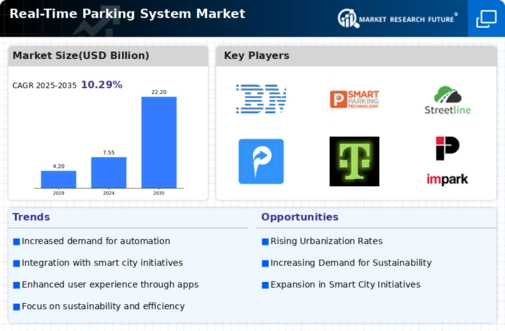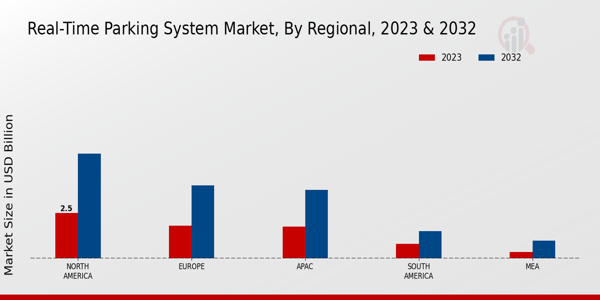Increasing Urbanization
The Global Real-Time Parking System Market Industry is experiencing growth driven by rapid urbanization. As cities expand, the demand for efficient parking solutions intensifies. Urban areas are projected to grow, leading to increased vehicle ownership and subsequently higher parking needs. For instance, metropolitan regions are witnessing a surge in population density, which exacerbates parking challenges. Real-time parking systems offer a solution by optimizing space utilization and reducing congestion. This trend is expected to contribute significantly to the market, with projections indicating a market value of 7.55 USD Billion in 2024, reflecting the urgent need for innovative parking solutions in urban environments.
Market Growth Projections
The Global Real-Time Parking System Market Industry is poised for substantial growth, with projections indicating a market value of 7.55 USD Billion in 2024 and an anticipated rise to 22.2 USD Billion by 2035. This growth trajectory suggests a compound annual growth rate (CAGR) of 10.29% from 2025 to 2035. Such figures underscore the increasing importance of real-time parking solutions in urban environments. Factors contributing to this growth include technological advancements, rising urbanization, and heightened consumer expectations for convenience. The market's expansion reflects a broader trend towards smart city initiatives and the integration of innovative technologies in urban infrastructure.
Technological Advancements
Technological advancements play a pivotal role in shaping the Global Real-Time Parking System Market Industry. Innovations such as IoT, AI, and mobile applications enhance the functionality and user experience of parking systems. These technologies facilitate real-time data collection and analysis, enabling users to locate available parking spaces quickly. Furthermore, smart sensors and automated payment systems streamline the parking process, making it more efficient. As cities adopt these technologies, the market is likely to witness substantial growth. The integration of advanced technologies is expected to drive the market towards a projected value of 22.2 USD Billion by 2035, indicating a robust trajectory fueled by innovation.
Rising Environmental Concerns
Rising environmental concerns are driving the Global Real-Time Parking System Market Industry towards sustainable solutions. As urban areas grapple with pollution and traffic congestion, there is a growing emphasis on eco-friendly transportation options. Real-time parking systems contribute to this by reducing the time vehicles spend searching for parking, thereby lowering emissions. Additionally, these systems can promote the use of electric vehicles by integrating charging station information. The market is expected to grow at a CAGR of 10.29% from 2025 to 2035, reflecting the increasing demand for environmentally responsible parking solutions that align with global sustainability goals.
Consumer Demand for Convenience
Consumer demand for convenience is a significant driver of the Global Real-Time Parking System Market Industry. As urban lifestyles evolve, individuals seek seamless and efficient parking experiences. Real-time parking systems cater to this demand by providing users with instant access to parking availability through mobile applications. This convenience not only enhances user satisfaction but also encourages the adoption of smart parking solutions. The increasing reliance on mobile technology among consumers further supports this trend. As the market evolves, the focus on user-friendly interfaces and integrated services is likely to propel growth, aligning with the broader shift towards convenience in urban living.
Government Initiatives and Regulations
Government initiatives and regulations are increasingly influencing the Global Real-Time Parking System Market Industry. Many governments are implementing policies aimed at reducing traffic congestion and promoting sustainable urban mobility. These initiatives often include investments in smart city projects that incorporate real-time parking solutions. For example, cities are adopting regulations that mandate the use of smart parking systems in new developments. Such policies not only enhance urban infrastructure but also encourage the adoption of technology-driven parking solutions. The alignment of government objectives with market growth is likely to foster an environment conducive to the expansion of the real-time parking sector.














